
# 4982-85 - 2015 First-Class Forever Stamp - Gifts of Friendship
U.S. # 4982-85
2015 49¢ Gifts of Friendship
The first “great war” of the 20th century was fought between Russia and Japan in 1904 and 1905. What could have become the first world war was calmed by the diplomacy of the United States. President Theodore Roosevelt invited the countries to conduct negotiations in New Hampshire, resulting in peace with the Treaty of Portsmouth.
Japan sought a way to thank the U.S. for its role in the negotiations. Learning of America’s desire for cherry trees, in 1909 the mayor of Tokyo offered to send the trees as a symbol of friendship between the nations. Some believe the gift also was made to help ease immigration tensions between the U.S. and Japan. When the trees arrived late in 1910 and were infested with pests and disease, the President himself had to authorize their burning to avoid a diplomatic crisis.
Two years later, the Tokyo mayor sent 3,020 more cherry trees that were successfully planted to replace the original gift. The U.S. reciprocated in 1915, when Howard Taft sent 50 flowering dogwood trees to Japan. The tree-giving tradition continues into the 21st century. Each spring, Japanese cherry trees still bloom in the U.S., as do American dogwoods in Japan. The trees remain living symbols of the enduring friendship between the two countries – their blossoms an inspiration for international peace throughout the world.
These stamps were part of a joint issue to commemorate the 100th anniversary of America’s gift of dogwood trees to the Japan in 1915. The sheet features four different stamp designs, two of which were designed by an American artist and two that were designed by a Japanese artist. Paul Rogers designed the stamps picturing the Lincoln Memorial with cherry trees an the U.S. Capitol Building with pink dogwood trees. Japanese artist Junko Kaifuchi designed the other two stamps picturing Tokyo’s National Diet Building with cherry blossoms and a clock tower with white dogwood flowers.
Treaty of amity and commerce signed

On July 29, 1858, the US signed the Treaty of Amity and Commerce with Japan, opening trade between the two nations.
Following continuing attempts by Europeans to convert the Japanese to Catholicism, Japan cut off nearly all outside contact in 1639. For more than 200 years, Japan permitted trade only with Dutch and Chinese ships bearing special charters.
On July 8, 1853, under the direction of President Millard Fillmore, Commodore Matthew Perry led four steamships into Tokyo Bay to open relations between Japan and the United States. The Japanese were impressed by the giant steamships, which they had never seen before and described as “giant dragons puffing smoke.”
Perry carried with him a letter for the Emperor from President Fillmore, requesting that Americans stranded in Japan be returned home and expressing interest in opening trade between the two nations. He also presented the emperor with a variety of gifts, including a working steam locomotive model, a telegraph, a telescope, and several wines and liquors, all intended to show the Japanese the superiority of American culture and benefits of trade.
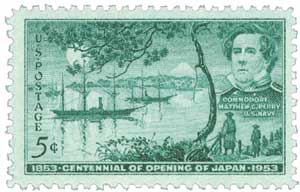
The following year, Perry returned on February 13 with 10 ships and 1,600 men. Though the Japanese resisted at first, they allowed him to land at Kanagawa (near present-day Yokohama). The two sides negotiated for several weeks before signing the Convention of Kanagawa on March 31, 1854.
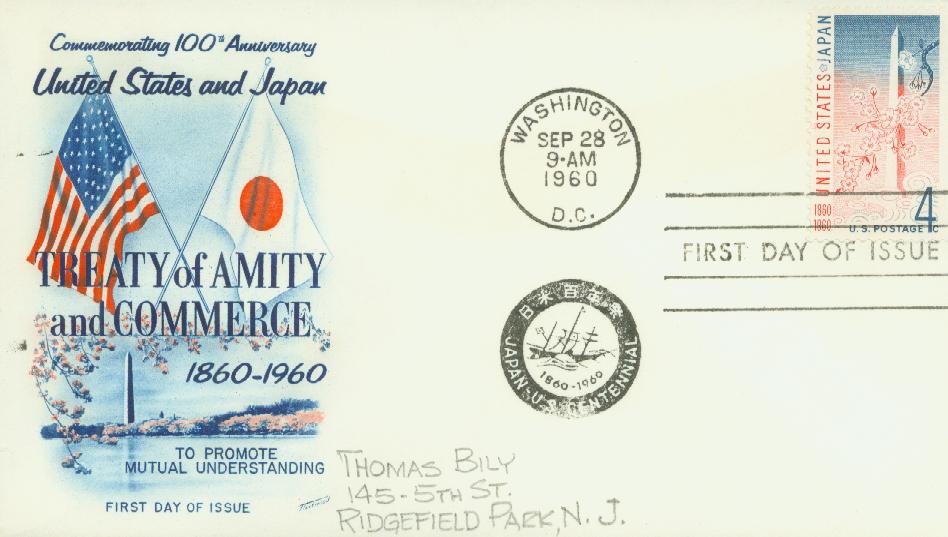
The 12-article treaty established peace between the two nations, opened the Japanese ports of Shimoda and Hakodate, permitted assistance to shipwrecked American sailors (and stated they wouldn’t be imprisoned or mistreated), allowed for currency exchange, forbid America from using any other Japanese ports, and opened an American consulate in Shimoda. The governments of both nations ratified the treaty nearly a year later, on February 21, 1855. The treaty was significant in that it led to several similar agreements between Japan and other nations.
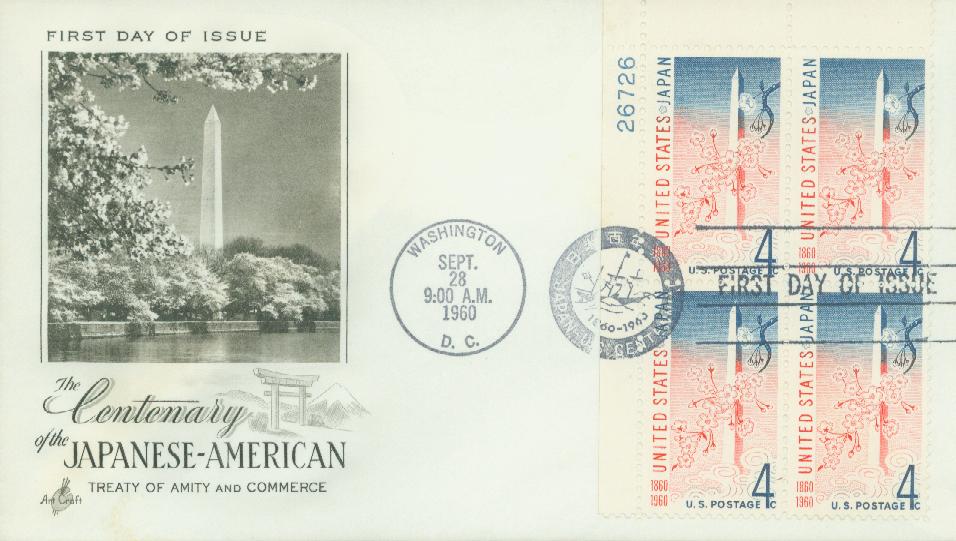
One thing that was missing from the Treaty of Kanagawa was trade. Perry left that issue to US envoy Townsend Harris. Harris spent two years convincing the Japanese to open trade with the US. When it became apparent that the British were planning to ask for the same privileges, the Japanese agreed to allow trade with the US.
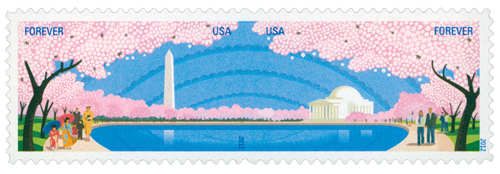
The Treaty of Amity and Commerce was signed in Shimoda on July 29, 1858, opening the ports of Edo, Kobe, Nagasaki, Niigata, and Yokohama to American trade. The treaty also granted US citizens the right to live and trade in those ports. It was officially ratified during the visit of the first Japanese Embassy to the US on April 12, 1860.
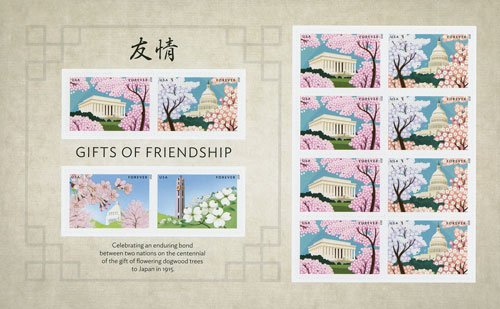
Click here to read the full treaty.
U.S. # 4982-85
2015 49¢ Gifts of Friendship
The first “great war” of the 20th century was fought between Russia and Japan in 1904 and 1905. What could have become the first world war was calmed by the diplomacy of the United States. President Theodore Roosevelt invited the countries to conduct negotiations in New Hampshire, resulting in peace with the Treaty of Portsmouth.
Japan sought a way to thank the U.S. for its role in the negotiations. Learning of America’s desire for cherry trees, in 1909 the mayor of Tokyo offered to send the trees as a symbol of friendship between the nations. Some believe the gift also was made to help ease immigration tensions between the U.S. and Japan. When the trees arrived late in 1910 and were infested with pests and disease, the President himself had to authorize their burning to avoid a diplomatic crisis.
Two years later, the Tokyo mayor sent 3,020 more cherry trees that were successfully planted to replace the original gift. The U.S. reciprocated in 1915, when Howard Taft sent 50 flowering dogwood trees to Japan. The tree-giving tradition continues into the 21st century. Each spring, Japanese cherry trees still bloom in the U.S., as do American dogwoods in Japan. The trees remain living symbols of the enduring friendship between the two countries – their blossoms an inspiration for international peace throughout the world.
These stamps were part of a joint issue to commemorate the 100th anniversary of America’s gift of dogwood trees to the Japan in 1915. The sheet features four different stamp designs, two of which were designed by an American artist and two that were designed by a Japanese artist. Paul Rogers designed the stamps picturing the Lincoln Memorial with cherry trees an the U.S. Capitol Building with pink dogwood trees. Japanese artist Junko Kaifuchi designed the other two stamps picturing Tokyo’s National Diet Building with cherry blossoms and a clock tower with white dogwood flowers.
Treaty of amity and commerce signed

On July 29, 1858, the US signed the Treaty of Amity and Commerce with Japan, opening trade between the two nations.
Following continuing attempts by Europeans to convert the Japanese to Catholicism, Japan cut off nearly all outside contact in 1639. For more than 200 years, Japan permitted trade only with Dutch and Chinese ships bearing special charters.
On July 8, 1853, under the direction of President Millard Fillmore, Commodore Matthew Perry led four steamships into Tokyo Bay to open relations between Japan and the United States. The Japanese were impressed by the giant steamships, which they had never seen before and described as “giant dragons puffing smoke.”
Perry carried with him a letter for the Emperor from President Fillmore, requesting that Americans stranded in Japan be returned home and expressing interest in opening trade between the two nations. He also presented the emperor with a variety of gifts, including a working steam locomotive model, a telegraph, a telescope, and several wines and liquors, all intended to show the Japanese the superiority of American culture and benefits of trade.

The following year, Perry returned on February 13 with 10 ships and 1,600 men. Though the Japanese resisted at first, they allowed him to land at Kanagawa (near present-day Yokohama). The two sides negotiated for several weeks before signing the Convention of Kanagawa on March 31, 1854.

The 12-article treaty established peace between the two nations, opened the Japanese ports of Shimoda and Hakodate, permitted assistance to shipwrecked American sailors (and stated they wouldn’t be imprisoned or mistreated), allowed for currency exchange, forbid America from using any other Japanese ports, and opened an American consulate in Shimoda. The governments of both nations ratified the treaty nearly a year later, on February 21, 1855. The treaty was significant in that it led to several similar agreements between Japan and other nations.

One thing that was missing from the Treaty of Kanagawa was trade. Perry left that issue to US envoy Townsend Harris. Harris spent two years convincing the Japanese to open trade with the US. When it became apparent that the British were planning to ask for the same privileges, the Japanese agreed to allow trade with the US.

The Treaty of Amity and Commerce was signed in Shimoda on July 29, 1858, opening the ports of Edo, Kobe, Nagasaki, Niigata, and Yokohama to American trade. The treaty also granted US citizens the right to live and trade in those ports. It was officially ratified during the visit of the first Japanese Embassy to the US on April 12, 1860.

Click here to read the full treaty.














